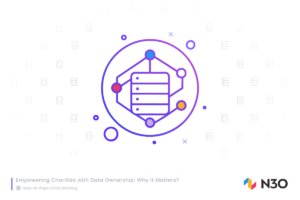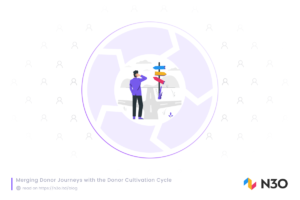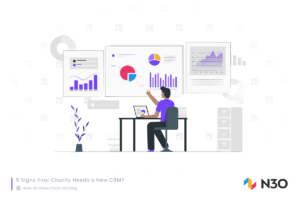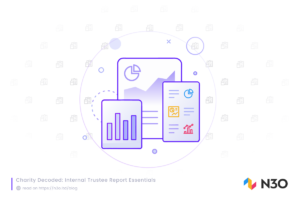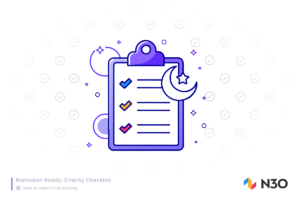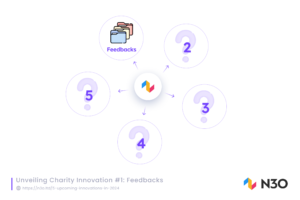NGOs rely on donations from various sources to run their operations and raise funds. A large part of this depends on developing a rapport and trust with donors through effective communication, with charities increasingly using call centres.
Call centres enable NGOs to engage with donors, communicate their causes, and solicit donations effectively. They allow NGOs to create public awareness about social issues and their campaigns and help advocate for the charities’ aims and objectives.
But when it comes to establishing a call centre, the question arises whether an in-house or an outsourced call centre is the best way forward? This article discusses why an in-house call centre may be a better option for charities.
What Is an In-House Call Centre?
An in-house call centre refers to a customer service operation directly owned, operated, and managed by the charity itself.
In this setup, the charity establishes a dedicated team of customer service representatives and support staff to handle inbound and outbound calls and other forms of customer communication, such as emails, live chat, and other interactions.
These call centres are typically located on the company’s premises or within the organisational structure.
On the other hand, an outsourced call centre is a business arrangement where a charity contracts with a third-party service provider to handle its customer service operations. The tasks and activities are similar to the in-house call centre. However, they are administered and managed by the third party’s management and temporary staff.
These call centres are typically off-site, often in different geographical locations or countries, and are operated and managed by external service providers.
6 Reasons Why an In-House Call Centre Is A Better Choice
In our opinion, an in-house call centre can help address various challenges NGOs face to generate more funds and, more importantly, develop better donor satisfaction. Here’s how!
1. Reduced Costs
While outsourcing a call centre may initially appear cost-effective, an in-house call centre can lead to much better long-term cost savings.
Reduced Operational Costs: The primary costs for call centres are generally restricted to staff, equipment and data management. Organisations can save considerably by hiring temporary staff or utilising volunteers for key campaigns. These can be part-time at competitive hourly rates compared to utilising external call centres, which will inevitably mark up on hourly rates.
From a technical perspective, the primary equipment needed to set up an in-house call centre include:
- Phone equipment (based on the number of agents)
- A virtual phone system such as 3CX or OpenPhone.
- A strong internet connection
- A CRM (with dialler functionality)
These are generally easy to set up and are often just one-off costs from the beginning.
Improved Donor Retention: The other element is that an effective donor service provided by an in-house call centre can lead to improved donor retention rates. Satisfied donors are more likely to remain loyal to a brand, resulting in reduced donor churn and the need for costly donor acquisition efforts.

Engage Call Centre Case Study:
An N3O client initially outsourced their call centre for a major campaign with a cost-to-income ratio of 1:2, amounting to approximately £45,000 in costs and generating £90,000 in income. However, after transitioning to an in-house hardware setup and utilising a CRM dialler along with temporary contract staff, the client significantly reduced costs to £15,000 while achieving increased revenue, reaching £150,000 in the following year!
This transformation resulted in an impressive improvement in the cost-to-income ratio, indicating a more efficient and profitable operation. Additionally, the client also experienced substantial savings for other campaigns, such as the winter campaign, totalling an estimated £70,000. The performance of the call centre in subsequent years showed income growth of approximately 25% YoY.
2. Personalised Communication
In-house call centre agents have a more profound knowledge of an organisation’s projects, services, and policies. This understanding enables them to offer donors personalised recommendations and suggestions, more effectively addressing their specific needs.
For example, a call centre member who has worked with a health charity for just 6 months is much more likely to know the details of the projects the charity is fundraising for. They can deal with questions on the impact of projects, key information and costs, which an external member would not be privy to immediately.
Direct Engagement with Organizational Culture: In-house call centre agents are immersed in the organisation’s culture, values, and mission. This familiarity allows them to represent the brand authentically, relate to the donor more personally, and build a stronger rapport, enhancing the overall donor experience.
Direct Access to Donor History: In-house call centres have direct access to comprehensive donor histories and profiles within the organisation’s CRM systems. Agents, therefore, have access to their previous interactions, donation history, and donor preferences, leading to better-informed interactions.

3. Quality Assurance
With an in-house call centre, you have complete control over your agents’ training, management, and quality assurance. It allows you to implement specific standards, protocols, and processes that align with your company’s values and goals, ensuring a high-quality donor experience.
Enhanced Brand Control: You can maintain greater control over the representation of your brand. You can train agents to embody your brand’s values, voice, and tone. Such consistency helps build trust and credibility among your donor base.
Tailored Training and Development Programs: Charities can design specific training and development programs for in-house call centre agents, enhancing interpersonal skills, product knowledge, and donor service techniques.
Integrated Feedback Mechanisms: Charities can integrate comprehensive feedback mechanisms within their in-house call centres to gather donor insights and suggestions.
For instance, an organisation responding to an emergency campaign may find that certain donors are affiliated (donating more) with a particular project under that campaign. The call centre team can record and share such information with internal teams. The project team can utilise this information by allocating more funds for that specific project or more.
Another example that highlights the benefit of having an in-house call centre is that during outbound calls, agents can record donors’ interest in sponsoring a child from a specific location (e.g. Pakistan). They can share such instances with the marketing team, using this insight to push more relevant marketing material to the target audience.
In short, having an in-house call centre leads to a direct and swift feedback mechanism.
Quick Discrepancy Handling: In-house call centres enable charities to promptly address donor concerns and issues without needing external escalations.
For example, call centre agents can get in touch with the relevant departments like finance, projects, and marketing instantly without delays. They won’t have to go through the communication channels that are normally involved in the case of outsourced call centres with agents who are not familiar with your organisation’s in-house teams.
4. Embedded Teams

An in-house call centre team is responsible for more than handling inbound and outbound calls. They can be an extension of your organisation, performing administrative tasks, complaint handling, setting up donor events, and more.
Since call centre teams take care of donors through various touch points, in some organisations, they are referred to as “Donor Care.” In addition to donor engagement and fundraising campaigns, below is a list of key tasks and operations performed by a call centre at the heart of a charity.
- Collecting donations: A key function of the call centre is to collect donations through targeted campaigns. Charities can define fundraising campaigns, targeting a specific demographic, regular donors or new subscribers.
- Event Support and Coordination: Assist in organising and managing charity events by inviting VIP attendees, providing event details, addressing event-related queries, and managing event registrations.
- Public Awareness and Education: Disseminating information about the charity’s initiatives, projects, and social causes through outbound calls, promoting public awareness, and educating the community about relevant social issues.
- Data Collection and Management: Gathering donor information, updating consent preferences, and ensuring accurate data management for effective donor communication and relationship management.
- Feedback Collection and Analysis: Collecting donor feedback, conducting surveys, and analysing donor responses to assess donor satisfaction, identify areas for improvement, and enhance donor engagement strategies.
- Emergency Response and Support: Handling incoming calls during emergencies or crises, supporting affected individuals or communities, and coordinating relief efforts in collaboration with other charity departments.
- Administrative Support: Assisting with administrative tasks, such as scheduling appointments, managing outbound communications, and providing general information about the charity’s operations and services.
- Collaborative Problem-Solving: Inbound call centres enable collaborative problem-solving by facilitating the flow of information from donors to different departments.
Various departments, such as fundraising, marketing, finance, and operations, can work together to address donor concerns, identify trends, and develop integrated solutions that align with donor needs and expectations.
5. Data Security
In-house call centres can offer greater data security and confidentiality as they are directly governed by your organisation’s data security policies and protocols. Since NGOs and charity organisations deal with financial and personal data, ensuring compliance with data protection regulations and safeguarding donor trust when handling sensitive donor information is crucial.
Secure IT Infrastructure and Systems: Charities can invest in secure IT infrastructure and systems to safeguard sensitive data within their in-house call centres. For instance, advanced firewalls, intrusion detection systems, and secure data storage solutions can strengthen the organisation’s defences against external cyber threats.
Limited Third-Party Involvement: By managing call centre operations in-house, charities can limit third-party involvement and minimise the risk of data exposure to external entities. Risks of external, temporary staff downloading donor data or taking screenshots of personal information can be monitored.
Immediate Response to Security Incidents: In-house call centres give charities direct control over incident response procedures in case of a data breach or security incident. With a well-defined incident response plan, charities can promptly address security threats and contain potential breaches.

6. Quicker Decision-Making
Inbound call centres generate a wealth of data related to donor preferences, pain points, and feedback. By leveraging this data, organisations can make informed, data-driven decisions aligned with donor needs and market trends.
An in-house call centre can seamlessly integrate with your organisation’s CRM system and other in-house databases. This integration allows for the efficient collection and analysis of donor data, enabling your organisation to gain valuable insights into donor preferences, behaviours, and pain points.
For instance, you can see which projects are getting more donations, how many donations are coming in for a particular call centre agent, how long each member has been on the call, and more. Based on this information, you can make necessary adjustments to your campaigns.
For example, an in-house call centre team can quickly switch campaigns if it’s not performing well compared to an outsourced call centre that may just be implementing what they have been told.
Call Tracking and Analytics: Inbound call centres can use call tracking and analytics tools to monitor key performance indicators (KPIs) such as call volume, call duration, call resolution rates, and donor satisfaction scores. By analysing this data, organisations can assess the effectiveness of different marketing campaigns and strategies, enabling them to make immediate, data-driven decisions.
Campaign-Specific Call Metrics: Inbound call centres can measure campaign success by implementing campaign-specific call metrics, such as the number of calls generated from a particular marketing channel or the conversion rates of calls to donations. These metrics help organisations assess their fundraising campaigns’ return on investment (ROI) and make informed decisions about resource allocation and future campaign strategies.
A Final Note – ENGAGE Call Centre Capabilities
At N3O, we recognise the difficulty and perceived complexity of charities running their own call centres. For that reason, we recently launched our NEW call centre module as part of our Engage CRM.
This feature supports a fully functional in-house call centre and allows you to manage both inbound and outbound calls. With our call centre feature, all of your call centre data is available in the Engage CRM. It eliminates the reliance on third-party call centre services and related tools.
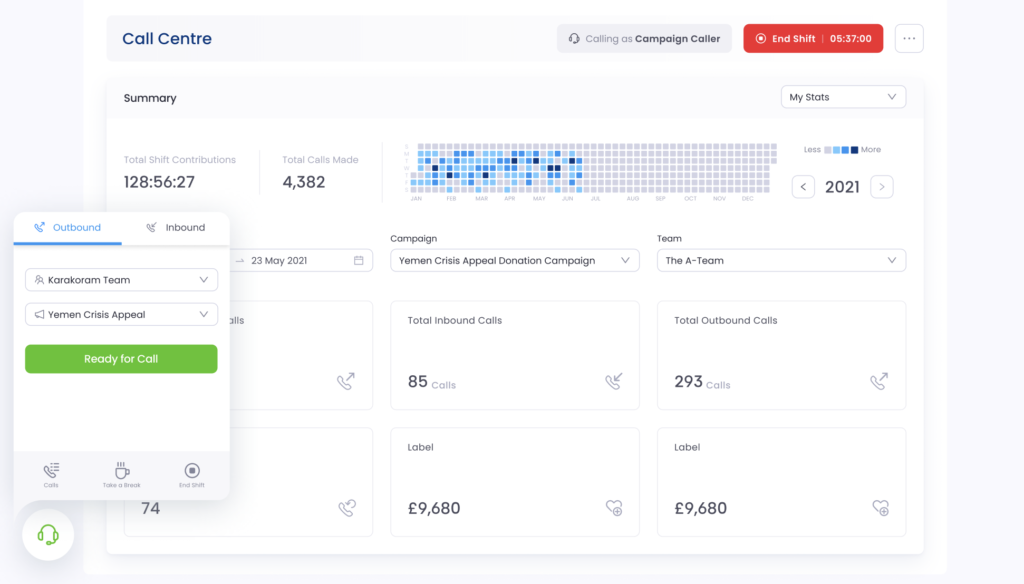
Our Call Centre function is capable of managing call centre staff. You can track call time and donations taken by each agent and set up an automated dialler to distribute phone numbers across your teams.
You can also set up campaigns and measure the performance of different teams. Moreover, it allows you to track the outcome of your calls and how it triggers your donors to take action. The call centre feature of Engage CRM lets you leverage automation effortlessly, resulting in a streamlined process and positive donor experience.
For more information, please don’t hesitate to contact us at mail@n3o.ltd.
